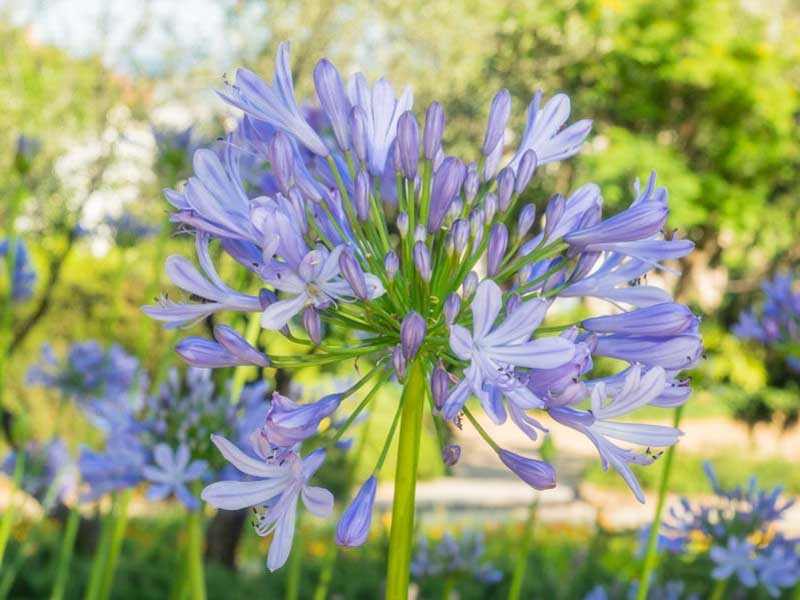Agapanthus Varieties: Picking the very best for Your Landscape
Agapanthus Varieties: Picking the very best for Your Landscape
Blog Article
Grasping the Art of Agapanthus Care: Important Steps for Healthy Growth and Vivid Flowers
In the world of cultivation, the farming of agapanthus stands as a gratifying undertaking for those who look for to support these sophisticated blooming plants. From picking the ideal selection to mastering pruning techniques, the journey in the direction of growing thriving agapanthus plants is complex and holds the key to opening the full possibility of these organic gems.
:strip_icc()/snow-storm-agapanthus-18f19b9a-3e7c6c88441b4127a9015f9a9fecec59.jpg)
Picking the Right Agapanthus Variety

When selecting the ideal Agapanthus variety for your yard, consider factors such as climate suitability, blossom color, and growth routine. Additionally, take into consideration the environment in your region to make sure the Agapanthus variety you choose can prosper in your particular problems. Recognizing the development behavior of different Agapanthus selections is essential for proper placement within your garden.
Ideal Growing Conditions
Considering the optimum ecological needs is necessary for successful Agapanthus farming. Agapanthus plants are delicate to cold temperature levels and need to be secured from frost throughout winter months.
To guarantee healthy development and lively flowers, plant Agapanthus light bulbs at a depth of concerning 2-4 inches and space them 8-12 inches apart. Including natural matter, such as garden compost, to the soil can boost water drainage and fertility, promoting robust root development. Mulching around the base of the plants aids preserve wetness and subdues weed development. Normal watering is crucial, especially throughout the growing period, to keep the soil regularly moist but not waterlogged.
Watering and Fertilizing Tips
Keeping appropriate moisture degrees and supplying essential nutrients are key components in the care regimen for Agapanthus plants. When it comes to watering Agapanthus, it is important to strike an equilibrium. These plants like regularly moist soil yet are susceptible to root rot if overwatered.
Feeding Agapanthus is vital for promoting healthy development and prolific blossoms. Apply a balanced plant food, such as a 10-10-10 formula, in the very early spring as new development arises. Repeat this application every 6-8 weeks throughout the growing period. Avoid extreme fertilizing, as it can result in rich vegetation at the expense of blossoms. Always comply with the supplier's instructions for correct dilution and application approaches. By following these watering and fertilizing ideas, you can guarantee your Agapanthus plants thrive and create vivid, long-lasting blooms.
Pruning Methods for Agapanthus
Pruning Agapanthus plants at her comment is here the appropriate times and with correct methods is vital for preserving their wellness and advertising optimum development and flowering. The ideal time to prune Agapanthus is in late wintertime or early spring prior to new growth emerges. Start by removing any type of yellowing or dead fallen leaves near the base of the plant. Cut them as close to the ground as possible without harming the emerging shoots.
Deadheading spent flowers can likewise redirect the plant's energy into producing even more flowers instead than setting seeds. If you desire to collect seeds for propagation, go to website leave some blossoms to completely dry and mature on the plant.
Keep in mind to use tidy, sharp devices to make precise cuts and minimize the risk of presenting diseases. Agapanthus. Routine trimming will aid keep your Agapanthus looking neat and healthy while ensuring a plentiful display of lovely blossoms
Taking Care Of Usual Pests and Diseases
After ensuring appropriate trimming methods for Agapanthus, it is essential to attend to typical parasites and diseases that can affect the wellness and vitality of these plants. Agapanthus plants are typically hardy yet can still succumb particular issues. One usual bug that influences Agapanthus is the Agapanthus gall midget. This tiny, orange fly lays its eggs in the foliage, bring about altered development and flower buds that fall short to open. To battle this parasite, official source trim and destroy any kind of affected plant components and think about making use of insecticidal soap.
One more common issue is fungal leaf place, which provides as dark sores on the leaves. To stop fungal conditions, guarantee great air circulation around the plants, prevent overhead watering, and get rid of any type of infected fallen leaves immediately. Furthermore, Agapanthus plants can suffer from origin rot if they are planted in badly draining pipes dirt. To avoid this, plant Agapanthus in well-draining dirt and prevent overwatering. By being attentive and taking prompt action against diseases and insects, you can assist your Agapanthus plants prosper and produce vivid blooms.

Verdict
Finally, mastering the art of agapanthus treatment involves choosing the ideal variety, giving perfect growing problems, appropriate watering and fertilizing, ideal pruning strategies, and addressing typical pests and conditions. By following these important actions, you can make certain healthy and balanced growth and vivid blooms for your agapanthus plants. Bear in mind to regularly monitor and maintain your plants to promote their overall health and durability.
To make sure healthy growth and dynamic flowers, plant Agapanthus bulbs at a deepness of concerning 2-4 inches and room them 8-12 inches apart. By complying with these watering and fertilizing suggestions, you can ensure your Agapanthus plants thrive and create vivid, lasting blossoms.
One usual pest that influences Agapanthus is the Agapanthus gall midge. Furthermore, Agapanthus plants can experience from root rot if they are grown in poorly draining pipes dirt. By following these vital actions, you can make certain healthy growth and lively blossoms for your agapanthus plants.
Report this page